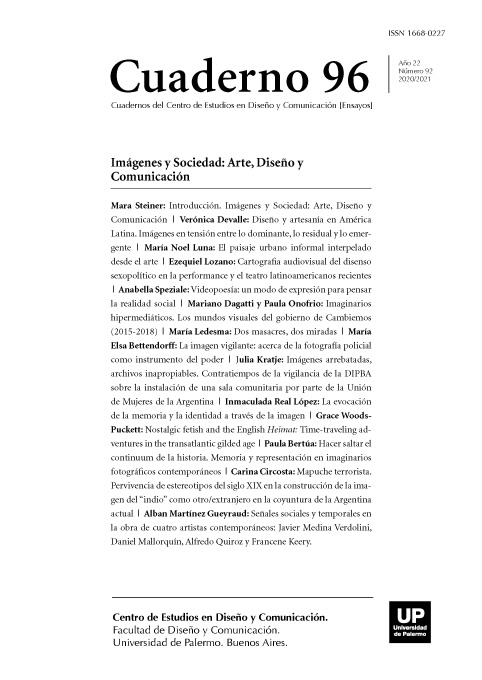Señales sociales y temporales en la obra de cuatro artistas contemporáneos: Javier Medina Verdolini, Daniel Mallorquín, Alfredo Quiroz y Francene Keery
Abstract
This article deals about some artistic works made by Javier Medina, Daniel Mallorquín, Alfredo Quiroz and Francene Keery. They are four contemporary artists who, based on inquiries in certain social issues and time´s symbols, work in Paraguay. Of Medina´s works the photographs from the Deconstrucciones (2012) and Bolivia (2014) series will be considered, which represent an analytical view at architecture, the city, the spaces, the cultural signs and the progrees. Of Mallorquín´s works, the samples Resiliencia (2012) and Discontinuum (2014) will be analyzed. This artist, sensitized from the fire of the supermarket Ycuá Bolaños that took place in 2004 (the greatest civil tragedy of recent times in Asunción-Paraguay), seeks to highlight that anguished and unjust reality that occurred deepening in it the experience of what is irreversible, that we must not forget, and showing its different edges. Of Kerry's works will take into account her photographs of the exhibition Paisajes Sagrados (2014), images of street mortuary niches, and of her exhibition Retratadas desde Adentro (2017), stories of women incarcerated in Buen Pastor penitentiary. While of Quiroz's works, the samples Pinturas/Dibujos sobre lienzo y papel (2012) and Ojalá te enamores (2017) will be studied; in both exhibitions, the artist builds a rich world in nuances and times, often hidden behind the obvious appearance of things. We could conclude that the four artists have built, each one in their own way, individual cosmogonies that, based on explorations around certain social and temporal issues, have translated into artistic works.
References
Altamirano, C. (2002). Términos críticos de sociología de la cultura, Buenos Aires: Paidós.
Assoun, P-L. (2004). Lacan, Buenos Aires: Amarrorfu. Barthes, R. (1980). La cámara lúcida. Nota sobre la fotografía, Barcelona, España: Paidós.
Benjamin,W. (1971). “Tesis de filosofía de la historia”, en Angelus Novus, Barcelona, España: Edhasa.
Bourdieu, P. (2003), Creencia artística y bienes simbólicos: elementos para una sociología de la cultura, Buenos Aires: Ed. Aurelia Rivera. Cauquelin, A. (2002). El arte contemporáneo, México D. F., México: Publicaciones Cruz O., S. A.
Deleuze, G. y Guattari, F. (2002). Mil mesetas (Capitalismo y esquizofrenia). Valencia, España: Pre-Textos.
Escobar, T. (2013). La invención de la distancia, Asunción, Paraguay: AICA Press, AICA Paraguay, and Fausto Ediciones.
Gombrich, E. H. (2003). Los usos de las imágenes. Estudios sobre la función social del arte y la comunicación visual, Madrid, España: Debate.
Perniola, M. (2002). El arte y su sombra, Madrid, España: Cátedra.
Rosset, C. (1993). Lo real y su doble. Ensayo sobre la ilusión, Barcelona, España: Tusquets.
Sloterdijk, P. (1998). Extrañamiento del mundo, Valencia, España: Pretextos.
Zambrano, M. (1992). Los sueños y el tiempo, Madrid, España: Ed. Siruela.
Los autores/as que publiquen en esta revista ceden los derechos de autor y de publicación a "Cuadernos del Centro de Estudios de Diseño y Comunicación", Aceptando el registro de su trabajo bajo una licencia de atribución de Creative Commons, que permite a terceros utilizar lo publicado siempre que de el crédito pertinente a los autores y a esta revista.


